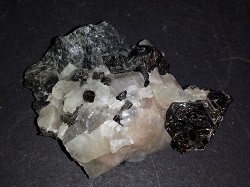A- |
B- |
C- |
D- |
E- |
F- |
G- |
H- |
I- |
J- |
K- |
L- |
M- |
N- |
O- |
P- |
Q- |
R- |
S- |
T- |
U- |
V- |
W- |
X- |
Y- |
Z |
PHYSICAL CHARACTERISTICS:
Color is brown, reddish brown, yellow and light to dark green. Luster is vitreous to dull. Transparency: Crystals are generally translucent, but some specimens are translucent. Crystal System is Monoclinic; 2/m. Crystal Habits include long prismatic crystals. Crystals can have a diamond-shaped cross-section although rarely symmetrical. Also found granular, massive and occasionally in radial aggregates. Cleavage is imperfect in two directions at 56 and 124 degrees. Fracture is uneven. Hardness is 5 - 6. Specific Gravity is approximately 2.9 - 3.3 (average for translucent minerals) Streak is brown. Other Characteristics: pleochroic in translucent specimens. Large crystals have an almost striated or grainy appearance. Associated Minerals are quartz, feldspars, aegirine, arfvedsonite, diopside, pectolite, phlogopite, chromite, Iron-nickel, roedderite, kosmochlor, krinovite, tainiolite, calcite, fluorite, svabite, sodalite and eudialyte. Notable Occurrences include the type locality of Langban Mine and Pajsberg, Varmland, Sweden as well as Mont Saint-Hilaire and Kipawa, Quebec, Canada; Myanmar; Madagascar and Leucite Hills, Wyoming and in the meteorite at Canyon Diablo, Arizona. Best Field Indicators are crystal habit (especially cross-section), color and cleavage.







